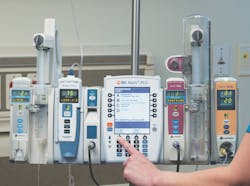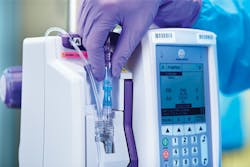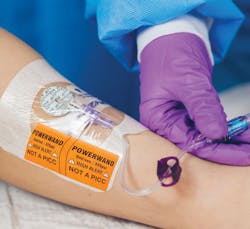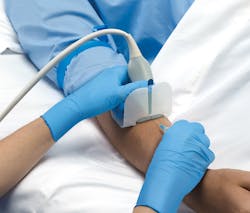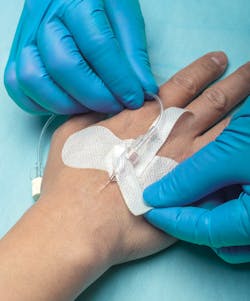Seventeenth-century English physician Thomas Sydenham is credited with the axiom “first, do no harm.” This advice on patient safety still stands today, a few centuries later, but possibly now there are myriad more opportunities for patient harm, however unintended. Two medical devices that are commonly recognized as sources of medical errors are infusion pumps and catheters of all sorts.
Infusion pumps
Intravenous (IV) infusion pumps deliver medication to the patient, and therein lies the potential for an adverse drug event (ADE). An ADE is injury due to a medical intervention related to a drug, including but not limited to medication errors and overdoses. Inpatient settings account for approximately one in three of all hospital ADEs, affect about 2 million hospital stays each year, and prolong hospital stays by 1.7 to 4.6 days, according to the Office of Disease Prevention and Health Promotion.1
Infusions cause 54 percent of ADEs, 56 percent of medication errors, and 61 percent of serious and life-threatening errors.2 AAMI News, referring to articles published in the fall 2015 issue of AAMI’s Horizons, stated that misuse, “overriding and manually bypassing key safety features of IV smart pumps often is to blame. Smart pumps are programmed with a built-in drug library and dose error reduction system to protect patients from programming errors by checking inputted information against approved safe dosing ranges.”2
Thomas Utech, PharmD, Worldwide Vice President, Global Solution Management & Marketing, Medication Management Solutions, BD, advised, “Minimizing medication errors while improving clinical efficiency is a top concern across the healthcare landscape. Healthcare executives are constantly looking for ways to leverage technology to support this outcome.”
Because the healthcare industry is under pressure to improve patient safety and care, Utech recommends a holistic approach for infusion-medication management.
Utech explained that BD’s smart-pump infusion system, Alaris System with Guardrails software, helps protect against infusion-pump medication errors in four ways. “First, infusion devices and modalities are standardized at the bedside and compounding equipment in the pharmacy. Then, the hardware is wirelessly connected with software and data on one platform, BD HealthSight.” He advised that those tasked with making a decision on choosing a smart pump should determine beforehand how the technology fits into the hospital’s future wireless and interoperability goals. “Next, the BD Alaris System and BD HealthSight solutions capture infusion data, for continuous quality improvement. Finally, the addition of the new BD HealthSight Clinical Advisor functionality aggregates disparate data from hospital systems to identify if a medication order is no longer clinically appropriate for a patient. The hosted software application enables robust medication-stewardship alerts, advanced analytics, and dashboards designed to improve patient outcomes.“To gain a holistic view of infusion- administration processes,” continued Utech, “the BD Knowledge Portal for Infusion Technologies is an intuitive, web-based reporting tool that quickly translates BD Alaris System data into actionable intelligence that helps drive clinical education, drug-library standardization, alarms management, and dose-error–reduction software compliance. Together with the BD HealthSight platform and its suite of advanced analytics solutions, actionable data can be accessed to help reduce variation and improve the practice. Device alarm data includes alarm types, counts, duration, care area, drug/fluid name, and the time associated with each infusion modality alarm, to help comply with The Joint Commission National Patient Safety Goals on Alarms Management.”
ICU Medical’s aim also is to improve patient safety through a more effectively designed infusion system. Matthew Hutchings, Vice President Global Marketing & Innovation, Infusion Systems, described ICU Medical’s Plum 360 infusion system as having a unique, proprietary, cassette delivery system that provides a direct connection for the secondary line, which helps to eliminate secondary set-up errors shown to occur in 48 percent of secondary infusions. “This includes eliminating the need for bag-height differential and alerting clinicians when a secondary clamp is left closed,” said Hutchings.
Hutchings referred to the Institute for Safe Medication Practices’ (ISMP) draft guidelines, which include a recommendation (item 1.7) for secondary delivery.3 “Use an automated secondary IV infusion management system that is not dependent on head height differential and has the ability to assure secondary flow.” Hutchings averred, “The Plum 360 infusion system meets this guideline for secondary delivery with the cassette-based delivery system.”
Talking about the high cost of sepsis and the role of an infusion system in its prevention, Hutchings noted that sepsis is the leading cause of death in hospitals and is the most expensive condition to treat, with U.S. total annual hospital costs of more than $24 billion.4 He also referred to a white paper from Premier Inc, “Creating a Culture of Optimal Care Delivery,” published in October 2018, that stated the average cost per case for hospital-associated sepsis has jumped more than 20 percent since 2015, in excess of $70,000.
“Research shows that poor sepsis outcomes occur when diagnosis and treatment are delayed,”5 said Hutchings. “The ‘sepsis bundle’ is the cornerstone of sepsis quality improvement. Two key elements of the bundle are the administration of broad-spectrum IV antibiotics and fluid resuscitation with an IV crystalloid fluid. The bundle should be started immediately upon diagnosis. The Plum 360 smart pump has the unique ability to guarantee secondary delivery, ensuring a secondary delivery of antibiotic is not missed.”
Hutchings cited a study by Prusch et al6 in support of IV interoperability as a patient-safety measure. The study aimed to develop, implement, and evaluate an IV interoperability program to improve medication safety at the bedside. The study concluded, “By integrating two stand-alone technologies, IV interoperability was implemented to improve medication administration. Medication errors were reduced, nursing workflow was simplified, and pharmacists became involved in checking infusion rates of IV medications.”6
Catheters and related devices
Most hospital patients have one or more catheters inserted during their stay. Patients, particularly the immunocompromised, are at risk of infection due to a catheter, because it is invasive and provides ingress to pathogens.
Doug Shook, Vice President of Marketing, Access Scientific, highlighted the attributes of POWERWAND midline and long peripheral intravenous catheters, made of ChronoFlex C with Bioguard technology in preventing potential infection. Infections become established on the catheter through the production of biofilm.7 He said they are the only noncoated catheter shown to inhibit bacterial attachment, even during extreme exposures. It also is FDA-cleared for thromboresistance. “These catheter characteristics help explain why only the POWERWAND has over 36,000 published catheter-days without a reported infection,” said Shook.
Access Scientific feels confident that users can achieve these results because of outcomes reported by current users. Furthermore, “If hospitals do not reach their targets, we provide meaningful reimbursement,” offered Shook.
POWERWAND midline catheters enable clinicians to remove central-venous– access devices sooner, according to Shook, which can help reduce the rate of infection. An outstanding example is found in a published scientific study focusing on Richmond Medical Center in Staten Island, which reduced CLABSI in one ventilator intensive-care unit by 100 percent using POWERWAND. The result was nearly $500k savings as compared with the previous year.8
Access Scientific has such confidence in their product that they offer a guaranteed reduction in total central-line–associated (CL) bloodstream infections (BSI; CLABSIs) and central-line usage. “We guarantee, by using POWERWAND, hospitals can reduce their total CLABSIs by 10 percent and central line usage by 25 percent.” That may represent a substantial savings, as Shook noted that the cost of a CLABSI is estimated at $48,000 per incident.
Vascular-access expert and consultant to Parker Laboratories, Inc, Nancy Moureau, RN, PhD, CRNI, CPUI, VA-BC, and CEO of PICC Excellence, told Healthcare Purchasing News that UltraDrape (Parker Laboratories) is designed specifically for ultrasound-guided (UG) peripheral intravenous (PIV; UGPIV) procedures. Its value lies in separation of the ultrasound probe and gel from the insertion site, enabling clinicians to maintain a sterile insertion site, thereby reducing the risk of infection associated with peripheral catheters.
Explaining that contamination during UGPIV procedures is a major concern, Moureau said, “Separating gel from the skin with a sterile barrier dressing promotes an aseptic UGPIV procedure by reducing contamination risk during and after insertion. It also eliminates post-insertion clean up.”
Moureau emphasized the importance of standardization and consistency in procedure. “While the Centers for Disease Control and Prevention require clinicians to maintain aseptic procedure for the insertion and care of intravascular catheters to prevent infections, inconsistent UGPIV practices minimize the effectiveness of aseptic techniques.”
Standardization of the insertion procedure with UltraDrape reduces touch contamination, improves visualization of the insertion site, and minimizes contamination that commonly occurs with cleaning gel off the skin. “It also provides a sterile barrier between the probe and insertion site, consistent with the Association for Vascular Access (AVA) Transducer Disinfection Guidance Document,9 which requires the probe to be covered or separated from the insertion site,” said Moureau.
An added value, according to Moureau, is that UltraDrape eliminates the need for supplies such as sterile gels, probe covers, adhesive films, and other cleaning items. Because it is an all-in-one barrier, it may also reduce labor costs.
She cited a scientific published study that found one hospital system reduced the cost of supplies used for UGPIV insertions by 55 percent with UltraDrape.10 “As reported at the 2019 AVA conference, a multi-center prospective study evaluated the UltraDrape standardized UGPIV procedure across three hospitals within the Sharp HealthCare system in San Diego, CA.10 Overall, 99 percent of clinicians in the study recommended adopting the standardized procedure, and a majority strongly agreed/agreed that UltraDrape improved patient safety by facilitating better aseptic technique.”
Vascular catheter-stabilization devices can help to prevent pistoning, accidental dislodgement, and needlestick injuries. Kurt T. Kyvik, Senior Product Manager, Dale Medical Products, described their catheter-securement devices’ attributes. “Dale Medical’s Hold-n-Place engineered stabilization devices 850 for PIV, arterial, and mid-line catheters and the Hold-n-Place 852 for central venous catheter, peripherally inserted central catheter, and arterial sheath devices are built on a history of hypoallergenic skin-safe products.” The devices are made of a soft, flexible, low-profile material, with no hard plastic to irritate the skin or attract patients’ attention. “In most applications, no skin prep is required, and no alcohol is required for removal,” added Kyvik.
The clinically familiar chevron securement technique is adaptable to many different single- and multi-lumen catheter configurations. Kyvik said that the chevron securement method prevents the rigid catheter hub and connectors from irritating the patient’s skin, reducing pistoning, twisting, and side-to-side movement of the catheter, keeping it secure from all directions, top, bottom, and sides.”
Kyvik explained that the Dale Hold-n-Place securement device separates the functions of securement and transparent dressing to maximize catheter security and purchasing flexibility. “Dale Hold-n-Place product numbers 848 and 854 feature a separate PrevahexCHX antimicrobial, transparent-film dressing, for added protection against CRBSI. Dale has the first and only securement kits to feature PrevahexCHX. Product numbers 849 and 853 feature a separate, regular, transparent dressing.”
Figuring it out
Whatever sort of infusion pump, catheter, or catheter-related device you are seeking to replace or upgrade, do your due diligence. Ask the vendor for the scientific evidence of efficacy in the form of independent studies published in respected medical journals. Multiple studies confirm claims of efficacy, because if the product works, results from these studies can be duplicated in other independent tests. That is the evidence you are looking for, and the vendors will be delighted to make it available to you.
References
1. Office of Disease Prevention and Health Promotion. Adverse drug events. https://health.gov/hcq/ade.asp
2. AAMI News. Helping smart pump technology deliver on its promise. November 2015. https://www.aami.org/productspublications/articledetail.aspx?ItemNumber=2873
3. Optimizing safe implementation and use of smart infusion pumps: ISMP post summit draft safe practice statements. https://www.ismp.org/sites/default/files/attachments/2019-03/Final_DraftSmartPump_Guidelines.docx
4. Torio CM, Moore BJ. National inpatient hospital costs: the most expensive conditions by payer, 2013. Healthcare Cost and Utilization Project. Statistical Brief #204. May 2016.
5. Paoli CJ, Reynolds MA, Sinha M, et al. Epidemiology and costs of sepsis in the United States – an analysis based on timing of diagnosis and severity level. Crit Care Med. 2018 Dec;46(12) :1889-1897.
6. Prusch AE, Suess TM, Paoletti RD, et al. Integrating technology to improve medication administration. Am J Health Syst Pharm. 2011;68(9):835-842.
7. Kombau C, Lee KC, Hughes GD, et al. Central line complications. Int J Crit Illn Inj Sci. 2015 Jul-Sep; 5(3):170–178.
8. Pathak R, Patel A, Enuh H, et al. The incidence of central line–associated bacteremia after the introduction of midline catheters in a ventilator unit population. Infect Dis Clin Pract (Baltim Md). 2015 May;23(3):131-134.
9. Thompson J, Garrett JH Jr. Transducer disinfection for evaluation and insertion of peripheral and central catheters for vascular access teams and clinicians. Journal of the Association for Vascular Access. 2018;23(3): 141-146.
10. Drafz M, Goeller K, et al. Efforts Toward standardization of UGPIV insertion through quantitative clinical product evaluation. Presented at the Association for Vascular Access Annual Scientific Meeting, Las Vegas, NV. October 2019. Poster.
About the Author

Susan Cantrell
Susan Cantrell is Infection Prevention Editor for Healthcare Purchasing News.

